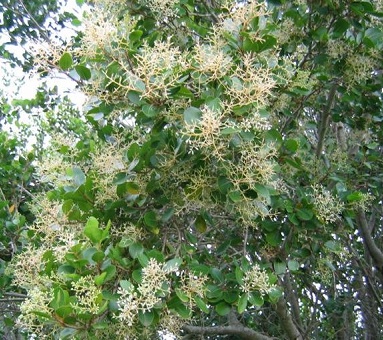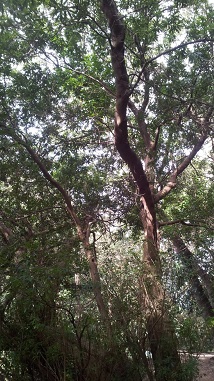White Alder – Platylophus trifoliatus
(Witels)
White Alder occurs in protected kloof forests along the mountain ranges from the Cape Peninsula to the Southern Cape.
The Tree
This is a small to large evergreen tree, reaching a height of between 8-25m and is often multi-stemmed, as coppice shoots start growing from an old stem.
The bark of a young tree is whitish-grey and sparsely fissured longitudinally, becoming brown and very rough with age.
The opposite, bright green leaves have long stalks – up to 40mm long – and three leaflets. The leathery serrated leaflets have no stalks, and are dark green above and paler green below. This is the only tree in southern Africa which has opposite, serrated leaves with three leaflets.
Small white fragrant flowers occur in dense, long-stalked panicles from the axils of the leaf stalks. December.
The fruit is a small pale yellow to dark brown capsule – about 10mm long – containing 2 reddish-brown seeds, occurring in autumn. April.
This is a very good honey tree as the flowers attract many bees and other insects. Birds eat most of the seeds and wild pigs eat the fruit capsules.

The heartwood varies in colour, ranging from a light pinkish-brown to mostly pinkish brown with darker marking. The sapwood is yellow and not clearly demarcated. The wood displays a large variation in density, colour and hardness. The wood has a slight satiny lustre. The wood is sweet-smelling, fine and even textured, with a straight grain, medium-hard and medium heavy.
Woodworking Properties
Due to the variation in density, colour and hardness, careful selection of material is necessary for the best results. The wood saws easily and works well. It planes easily and gives a beautiful finish with scraping. The wood glues and nails. It also takes all finishes well.
Using the Wood
The wood is hard and medium heavy. It is good for boat keels, window frames, etc. It is very durable in contact with soil or water. Because of the beautiful grain, it is popular for furniture, cabinetry, decorative veneer, interior trimming, joinery and turnery. In the past, it was used for light construction, mining timber, railway sleepers, boat building, window frames and fence posts.
Green weight: 1040 kg/m3
Dry weight: 595 kg/m3
Source : Trees of the Garden Route / Elna Venter
Southern African Wood / Stephanie Dyer, Barry James & Danielle James
If you are looking to buy wood, please click here to visit our Timber slab sales page.


